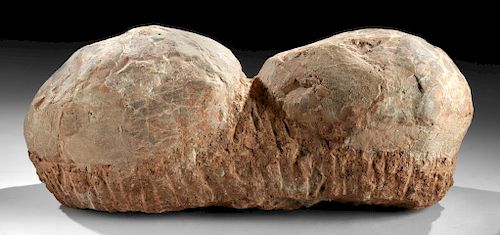Chinese Cretaceous Hadrosaur Dinosaur Eggs
Lot 195
About Seller
Artemis Gallery
686 S Taylor Ave, Ste 106
Louisville, CO 80027
United States
Selling antiquities, ancient and ethnographic art online since 1993, Artemis Gallery specializes in Classical Antiquities (Egyptian, Greek, Roman, Near Eastern), Asian, Pre-Columbian, African / Tribal / Oceanographic art. Our extensive inventory includes pottery, stone, metal, wood, glass and textil...Read more
Categories
Estimate:
$2,400 - $3,600
Absentee vs Live bid
Two ways to bid:
- Leave a max absentee bid and the platform will bid on your behalf up to your maximum bid during the live auction.
- Bid live during the auction and your bids will be submitted real-time to the auctioneer.
Bid Increments
| Price | Bid Increment |
|---|---|
| $0 | $25 |
| $300 | $50 |
| $1,000 | $100 |
| $2,000 | $250 |
| $5,000 | $500 |
| $10,000 | $1,000 |
| $20,000 | $2,500 |
| $50,000 | $5,000 |
| $100,000 | $10,000 |
| $200,000 | $20,000 |
About Auction
By Artemis Gallery
Jan 7, 2020
Set Reminder
2020-01-07 10:00:00
2020-01-07 10:00:00
America/New_York
Bidsquare
Bidsquare : VARIETY AUCTION - Antiquities / Ethnographic
https://www.bidsquare.com/auctions/artemis-gallery/variety-auction---antiquities-ethnographic-4787
Around the world & back in time - be amazed at the treasures you will find. Antiquities from Egypt, Greece, Italy and the Near East, Asian, Pre-Columbian, African / Tribal / Oceanic, Native American, Spanish Colonial, Russian Icons, Fine Art, much more! Artemis Gallery info@artemisgallery.com
Around the world & back in time - be amazed at the treasures you will find. Antiquities from Egypt, Greece, Italy and the Near East, Asian, Pre-Columbian, African / Tribal / Oceanic, Native American, Spanish Colonial, Russian Icons, Fine Art, much more! Artemis Gallery info@artemisgallery.com
- Lot Description
**Originally Listed At $1200**
Eastern Asia, China, Henan Province, late Cretaceous, ca. 100 to 65 million years ago. A connected pair of round fossilized eggs preserved in their original matrix, which is deep red compacted sandstone, from a member of the hadrosaur family (Hadrosauridae). The Hadrosaurids are also known as the duck-billed dinosaurs, a herbivorous type of animal and a facultative biped, meaning that they walked on two legs when young and four when adults. They had large jaws with multiple rows of teeth for grinding plants. They had large noses; some of them also had crests atop their heads whose use is still unknown: maybe to attract mates, scare away predators by appearing large, or make trumpeting sounds. Hadrosaurs were scaled, not feathered, based on skin impressions. We think that they were muscular animals who could have outrun contemporary predators, like tyrannosaurs. They were also large - roughly 30 feet long (9.2 m) and weighing up to three tons. Size: 11" W x 4.5" H (27.9 cm x 11.4 cm)
In the past few decades, paleontological research in China has rewritten our knowledge of dinosaurs, especially the later Cretaceous period, which was previously known mainly from western North America. Incredible finds of fossilized skeletal remains, eggs, nests, footprints, and related non-dinosaur animals and plants have given us a new understanding of how dinosaurs lived - and how they parented. These animals seem to have been devoted parents, nurturing their children from eggs through childhood.
Provenance: ex-A Coin Exchange, Tarzana, California, USA, acquired at the Tucson Gem and Mineral Show in 2008
All items legal to buy/sell under U.S. Statute covering cultural patrimony Code 2600, CHAPTER 14, and are guaranteed to be as described or your money back.
A Certificate of Authenticity will accompany all winning bids.
We ship worldwide and handle all shipping in-house for your convenience.
#147283Small losses to surface as shown. A few small areas of stabilization with glue where the egg shell meets the matrix.Condition
- Shipping Info
-
All shipping is handled in-house for your convenience. Your invoice from Artemis Gallery will include shipping calculation instructions. If in doubt, please inquire BEFORE bidding for estimated shipping costs for individual items.
-
- Buyer's Premium



 EUR
EUR CAD
CAD AUD
AUD GBP
GBP MXN
MXN HKD
HKD CNY
CNY MYR
MYR SEK
SEK SGD
SGD CHF
CHF THB
THB















